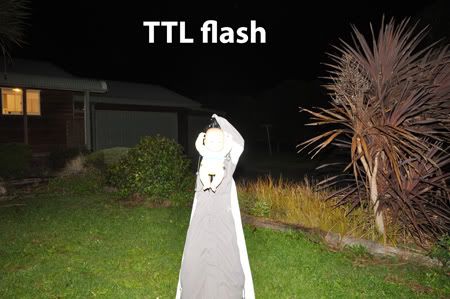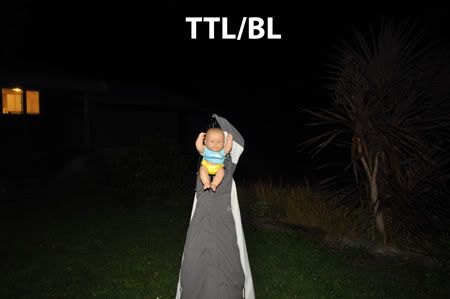Saturday, March 20, 2010
Monday, March 15, 2010
TTL/BL and metering modes .
In my video on how TTL/BL responds to a change in the meter someone suggested that it was not the movement of the meter that caused this change but rather the fact that the change from Centre Weighted metering to Matrix metering caused the flash system to meter differently . This is not so . TTL/BL uses the focus point diamond for its metering regardless of whether you choose matrix or CW metering - these modes do not change how the flash system meters .
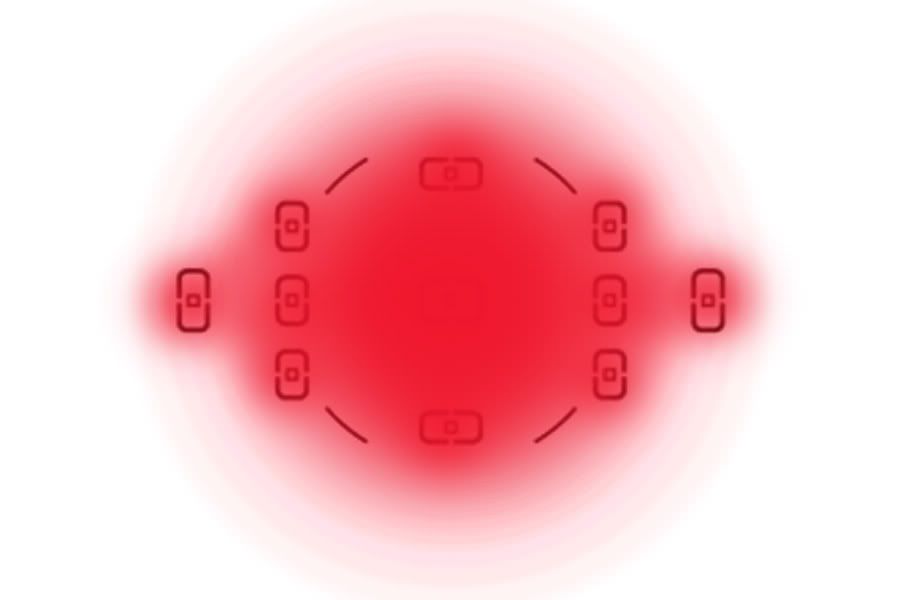
The reason for the change in output is that TTL/BL is trying to balance the flash with the ambient already on the subject . If you are in CW metering mode with the meter centered while shooting manual , and you change to matrix metering which decides the subject is underexposed and causes the meter to suddenly register "-1" then TTL/BL will increase its output - not because of the different metering mode but rather because it noticed the meter change . It decides that since the ambient is underexposed it may as well take over the exposure by increasing flash output .
My thought on the fact that you can't use TTL/BL with spot metering is that perhaps spot metering 'switches off' the rest of the metering pattern so TTL/BL can't do its calculations and therefore reverts back to TTL metering with the centre of the frame .
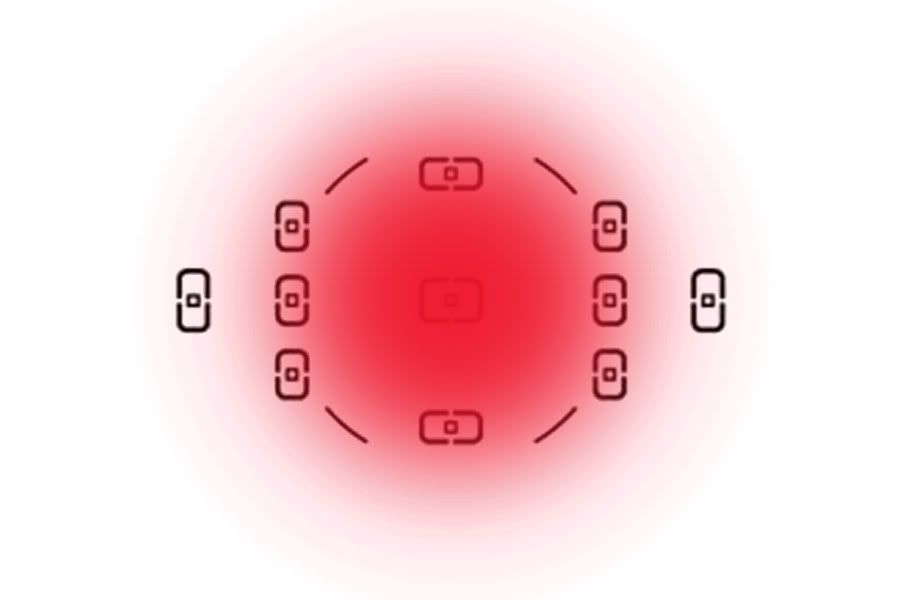
Either way I see no reason to suspect that the different metering modes [ CW vs matrix ] cause TTL/BL to meter with a different pattern - it still uses the focus point diamond - as with wireless CLS .
Sunday, March 7, 2010
TTL/BL and bounce flash under-exposure .
I still need to do some more tests with bounce flash in various situations to 'nail' the equation .
With 'normal' bounce flash and perhaps the bounce card out or the diffuser dome on and a fair amount of 'forward ' light TTL/BL does a good job . But as soon as the flash head is pointed backwards and the distances start changing TTL/BL tends to expose for " the brightest object in the focus point diamond " which means that it under-exposes when there is white in the frame ....
Lots of forward light = good exposure .
With 'normal' bounce flash and perhaps the bounce card out or the diffuser dome on and a fair amount of 'forward ' light TTL/BL does a good job . But as soon as the flash head is pointed backwards and the distances start changing TTL/BL tends to expose for " the brightest object in the focus point diamond " which means that it under-exposes when there is white in the frame ....
Lots of forward light = good exposure .
Only bounce light = under-exposure with white in the frame .
I still need to do some tests to confirm my suspicion but I'm thinking that perhaps TTL/BL still 'remembers' the distance info from the lens when you tilt the flash head and doesn't totally forget about it .
Perhaps it determines a minimum output for ''if the flash head was still facing forward'' and doesn't drop below that amount while still using part of its program to prevent blown highlights - which may be what backs off the exposure for whites to an average gray .
At a set distance with the flash head facing forward it can 'conclude' that an object 'must be white' if it is reflecting so much light back on the pre-flash since it knows its distance , but when the flash head is tilted and it doesn't know how far the light will travel then it has to start using its ''preserve highlights'' part of the program along with the ''minimum output'' from distance info data [ perhaps ] which allows it to be quite accurate with a decent amount of forward flash .
Perhaps this is why the manual suggests leaving the diffuser dome on at a 60 degree angle ''for best results ' ?
I'm going to have to work out some sort of a test to figure this one out because this is the final link to '' predictability '' of flash with TTL/BL mode .
Friday, March 5, 2010
10.) TTL/BL "Maps out" its subject .
Disclaimer : This theory is made up based on my studies of TTL/BL and is not information from Nikon themselves .... but I still think it may be the truth .
This may be the most simple fact of TTL/BL - or just my wild speculation , but the easiest way to understand the fact that TTL/BL has a similar consistency to matrix metering is to think of it as the same program in that it can 'map out' its subject based on colour information [and the pre-flash reading] .
How can TTL/BL have greater consistency regardless of subject size unless it is totally independent of subject size ?
I'll start off with a simple subject with a dark background .
Whether we have the subject under-exposed or correctly exposed TTL sees this : The area it meters off - end of story .
TTL/BL sees the subject based on the matrix metering pattern which is what gives it the edge with reflective subjects [ more on that later ] .
TTL needs to get an average gray in the centre of the frame and fires stronger when the subject does not fill the frame ....
to get this result .. [ average filter applied to centre of frame ]
If it does work the same way then my understanding of this is that TTL/BL can analyze the matrix metering pattern before the flash fires ....
This may be the most simple fact of TTL/BL - or just my wild speculation , but the easiest way to understand the fact that TTL/BL has a similar consistency to matrix metering is to think of it as the same program in that it can 'map out' its subject based on colour information [and the pre-flash reading] .
How can TTL/BL have greater consistency regardless of subject size unless it is totally independent of subject size ?
I'll start off with a simple subject with a dark background .
Whether we have the subject under-exposed or correctly exposed TTL sees this : The area it meters off - end of story .
TTL/BL sees the subject based on the matrix metering pattern which is what gives it the edge with reflective subjects [ more on that later ] .
TTL needs to get an average gray in the centre of the frame and fires stronger when the subject does not fill the frame ....
to get this result .. [ average filter applied to centre of frame ]
TTL/BL on the other hand fires a pre-flash [ as does TTL ] and 'maps out ' its subject based on the reading it receives ....
It uses the 'focus point diamond' to determine where its subject is and 'maps it out' rather than relying on it being a certain size .
And gives a much better exposure ....
Then we move the subject off-centre and see what TTL does to get an average gray in the centre of the frame ....
TTL flash still only sees the centre of the frame and has to totally over-expose the subject to get its average gray in the centre circle ...
Now here's how I define TTL/BL metering , if the subject is off centre it is still using the focus point diamond to 'find' its subject and 'map it out ' and so maintains consistency with its output .
When it did its pre-flash it mapped out the subject using the matrix metering pattern and was not fooled by the off-centre subject [ which is why you don't need to use 'fv-lock' with TTL/BL ] .
Here's another two samples with the subject below the centre of the frame .... TTL :
TTL/BL :
I can think of no possible scenario where TTL will beat TTL/BL with direct flash [ which you would mostly use outdoors ] . In brighter light [ with the ambient closer to correct exposure ] TTL/BL will back off accordingly while TTL will fire at exactly the same power it has here .
On to the 'reflections' ... This is just theory based on some 'borrowed' information from the Canon E-TTL system . The Nikon manual mentions that TTL/BL is good for reflective surfaces but doesn't explain why . Obviously we can't simply assume that Canon and Nikon flash works the same way but much of E-TTL appears to work the same as TTL/BL and it is a useful explanation with regard to E-TTL which mentions that " E-TTL II examines all evaluative metering zones both before and after the E-TTL preflash goes off. Those areas with relatively small changes in brightness are then weighted for flash metering. This is done to avoid the common E-TTL problem of highly reflective materials causing specular highlights in a flash-illuminated image and throwing off the flash metering. ". As mentioned we can't 'assume' that TTL/BL and E-TTL work exactly the same way but it's a highly likely possibility .
If it does work the same way then my understanding of this is that TTL/BL can analyze the matrix metering pattern before the flash fires ....
And then when it fires the pre-flash it can trace out the subject and pick up the reflections and reject them from the metering equation ...
This may also be why TTL/BL doesn't work when you switch to spot metering . It needs the whole pattern to be active to do its calculations . Changing to spot metering 'switches off' the rest of the metering pattern and so TTL/BL can't do its calculations unless you are in centre weighted or matrix metering - because then the whole pattern is available for its use .
Incorrect flash information in books
To make beginners feel better : professionals make mistakes too - but unfortunately sometimes they publish them as well .
Why do people write photography books ? For the money , not because they want to help people !
{Please note : I am not condemning entire books - just warning about information that could be misleading to a beginner - the rest of the information in the books mentioned is useful ! }
Many of these people are very knowledgeable about photography but are not necessarily 100% right in all their statements .
As I read through some of the more popular books I see mistakes that could greatly mislead beginners so I thought I would list them here for the benefit of beginners trying to find their way through a sea of [ sometimes incorrect] information .
It's confusing enough as a beginner without reading misleading statements that could further confuse your learning process !
I am busy with this book and on page 18 the author makes the statement about "BL" flash that in this mode " the flash is trying to make the foreground and background roughly equivalent exposure zones " .... that's close to what the manual says which is also ambiguous . Then he goes on to state that if the background is dark it will blow the subject trying to light the background as well . Nothing could be further from the truth ! In my blog on TTL/BL I explain my tests and how it really works .
{5/03/2010 :
I've decided to expand on this particular subject since many are questioning my basis for stating that the book's description is totally wrong . The problem lies primarily with Nikon who haven't explained things properly to us .
Page 37 of the SB800 manual describes TTL/BL flash in a very ambiguous way [ I'll go so far as to say the manual is wrong as well in this respect ] ... with regard to TTL/BL "Automatic balanced Fill Flash " it states " The flash output is adjusted for a well balanced exposure of the main subject and background " .... work that one out without getting everyone confused . I started doing tests with TTL/BL flash almost a year ago on Nikoncafe . After many test images [ you can see them on my photobucket album in the "flash" album , most have text on them ] I concluded that TTL/BL only cares about correct exposure on the subject and is far more accurate than TTL flash .
To stick to the subject at hand with TTL/BL it would be more accurate to read : " The flash output level is automatically adjusted for a well balanced exposure of the main subject taking the 'background' or ambient lighting already on it into account " .
As they say "a picture speaks a thousand words "
The author stated that the flash would "arm the photon warhead " and " obliterate the darkness " .. some simple tests will confirm the inaccuracy of this statement .
To digress slightly TTL flash does this when the subject is smaller than the metering area in the centre of the frame ...
The incorrect statement is due to a rather ambiguous statement in the Nikon manual that has been badly misinterpreted . In reality , the wireless CLS that the author praises so highly uses the same metering mode as TTL/BL ! BL mode will try to get perfect exposure on the subject " and take the ambient[ background] lighting on the subject into account " - that's the balancing part of it .
On to page 258 " I want the light source to be at least twice as far away as I had it , so that's gonna mean twice the power " ..... this is totally wrong , due to the inverse square law twice the distance means 4X the power !
This may have been a genuine mistake overlooked by a hasty review before publishing - but it's going to have a lot of beginners believing the wrong thing .
The other book I was reading recently ....
Why fire the flash at the moon and only get 0.05% of the flash power hitting the subject ? That's one way to fry a flash and waste battery power .
On to the tests :
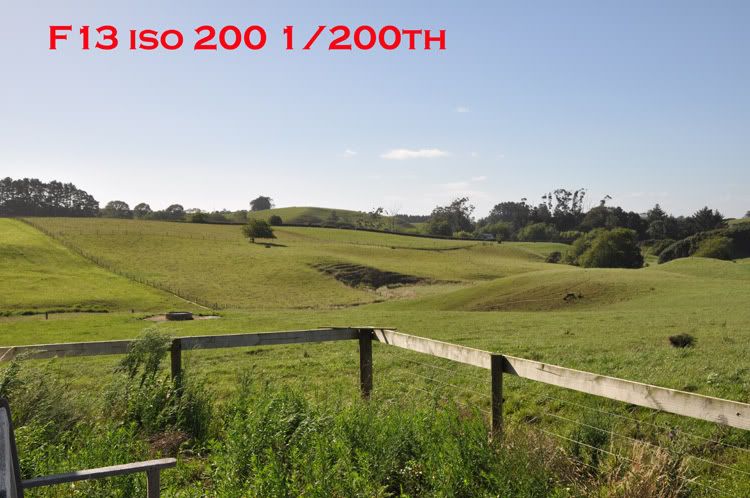
To give him the benefit of the doubt I stood 6 feet away , he mentioned 8-10 feet .
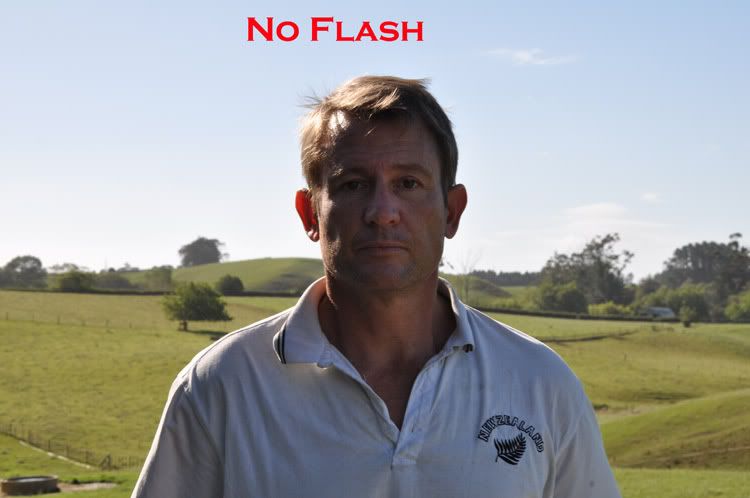
Just to make sure we were getting the full potential of the flash I set the flash to manual and full power ....
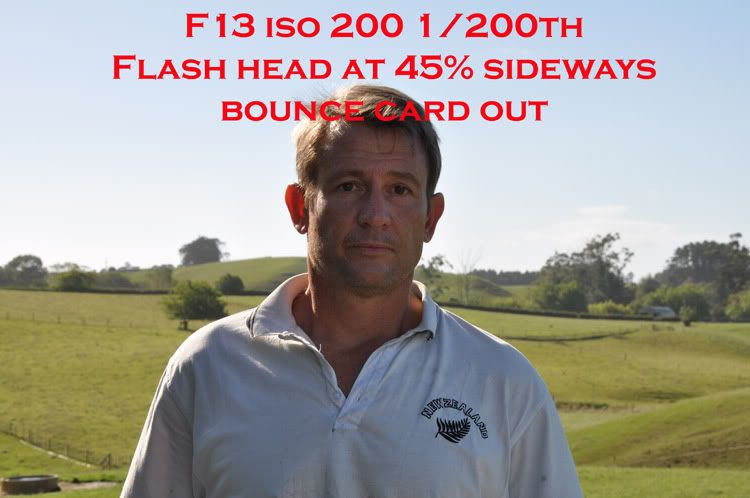
Pretty dismal isn't it [ not the subject! ]
Then I went to TTL/BL -1 direct flash ...

I won't show the picture of my face 2 feet from the camera but when I put the camera in manual at those settings at 1/128th power it tells me I have 0.6m working distance .... with direct flash that is .
At 0.6m [ 2 feet ] with the flash in the suggested position there is still not enough flash at full power .... this suggests that we are getting less than 1/128th of the power from the sideways light using the suggested setup .
You will use more than 150 X the flash power and flatten your batteries more than 150 X faster using this ' technique ' .
I rest my case ... it's a bad suggestion regardless of who made it .
When I buy a camera I expect everything on it to work .
I expect everything in the manual to be correct .
And when I pay for a book of photography knowledge I expect it to be correct .
If anyone has anything to add to this page please let me know !
Why do people write photography books ? For the money , not because they want to help people !
{Please note : I am not condemning entire books - just warning about information that could be misleading to a beginner - the rest of the information in the books mentioned is useful ! }
Many of these people are very knowledgeable about photography but are not necessarily 100% right in all their statements .
As I read through some of the more popular books I see mistakes that could greatly mislead beginners so I thought I would list them here for the benefit of beginners trying to find their way through a sea of [ sometimes incorrect] information .
It's confusing enough as a beginner without reading misleading statements that could further confuse your learning process !
I am busy with this book and on page 18 the author makes the statement about "BL" flash that in this mode " the flash is trying to make the foreground and background roughly equivalent exposure zones " .... that's close to what the manual says which is also ambiguous . Then he goes on to state that if the background is dark it will blow the subject trying to light the background as well . Nothing could be further from the truth ! In my blog on TTL/BL I explain my tests and how it really works .
{5/03/2010 :
I've decided to expand on this particular subject since many are questioning my basis for stating that the book's description is totally wrong . The problem lies primarily with Nikon who haven't explained things properly to us .
Page 37 of the SB800 manual describes TTL/BL flash in a very ambiguous way [ I'll go so far as to say the manual is wrong as well in this respect ] ... with regard to TTL/BL "Automatic balanced Fill Flash " it states " The flash output is adjusted for a well balanced exposure of the main subject and background " .... work that one out without getting everyone confused . I started doing tests with TTL/BL flash almost a year ago on Nikoncafe . After many test images [ you can see them on my photobucket album in the "flash" album , most have text on them ] I concluded that TTL/BL only cares about correct exposure on the subject and is far more accurate than TTL flash .
To stick to the subject at hand with TTL/BL it would be more accurate to read : " The flash output level is automatically adjusted for a well balanced exposure of the main subject taking the 'background' or ambient lighting already on it into account " .
As they say "a picture speaks a thousand words "
The author stated that the flash would "arm the photon warhead " and " obliterate the darkness " .. some simple tests will confirm the inaccuracy of this statement .
To digress slightly TTL flash does this when the subject is smaller than the metering area in the centre of the frame ...
Now we go to TTL/BL , due to the fact that it can 'map out' its subject using the matrix metering pattern - and has the advantage of distance info - it is much more accurate :
So : Did TTL/BL try to obliterate the darkness ? No , it concentrated on the subject . If anyone still doesn't believe me than all you have to do is try it out for yourself and you will see that the statement that TTL/BL will try to light the background is totally wrong .
So , Never base your statements on something you have read in a manual or heard form someone else - do your own tests and you will learn so much more .... and never make statements in a book based on what you think the manual means - it will get back to you in the end ! }
The incorrect statement is due to a rather ambiguous statement in the Nikon manual that has been badly misinterpreted . In reality , the wireless CLS that the author praises so highly uses the same metering mode as TTL/BL ! BL mode will try to get perfect exposure on the subject " and take the ambient[ background] lighting on the subject into account " - that's the balancing part of it .
On to page 258 " I want the light source to be at least twice as far away as I had it , so that's gonna mean twice the power " ..... this is totally wrong , due to the inverse square law twice the distance means 4X the power !
This may have been a genuine mistake overlooked by a hasty review before publishing - but it's going to have a lot of beginners believing the wrong thing .
The other book I was reading recently ....
.... has a suggestion on page 41 about using fill flash outdoors .
I have seriously never seen anything so pointless !
How much of the light in this image do you think is going to go sideways .... maybe 1% of 5% ? You'll have your flash firing at full power every shot just to put catch-lights in the subjects eyes , and those catch-lights will be "L"- shaped .
No wonder we have global warming and professionals complain about burning out flash heads !
Please note : I agree that fill flash should be used outdoors ! You will do well to follow the advice to use it .... BUT : wasting flash into the air makes no sense when you can simply dial back direct flash for the same results and use less than 1/100th of the power .
This weekend I will do some tests to verify the amount of flash that hits the subject with the bounce card .
With outdoor flash you will have the flash dialed down , your working distance will already be greatly reduced and you will hardly notice direct flash at -3 compensation when used as fill flash .Why fire the flash at the moon and only get 0.05% of the flash power hitting the subject ? That's one way to fry a flash and waste battery power .
On to the tests :

To give him the benefit of the doubt I stood 6 feet away , he mentioned 8-10 feet .

Just to make sure we were getting the full potential of the flash I set the flash to manual and full power ....

Pretty dismal isn't it [ not the subject! ]
Then I went to TTL/BL -1 direct flash ...

I won't show the picture of my face 2 feet from the camera but when I put the camera in manual at those settings at 1/128th power it tells me I have 0.6m working distance .... with direct flash that is .
At 0.6m [ 2 feet ] with the flash in the suggested position there is still not enough flash at full power .... this suggests that we are getting less than 1/128th of the power from the sideways light using the suggested setup .
You will use more than 150 X the flash power and flatten your batteries more than 150 X faster using this ' technique ' .
I rest my case ... it's a bad suggestion regardless of who made it .
When I buy a camera I expect everything on it to work .
I expect everything in the manual to be correct .
And when I pay for a book of photography knowledge I expect it to be correct .
If anyone has anything to add to this page please let me know !
Subscribe to:
Posts (Atom)

















